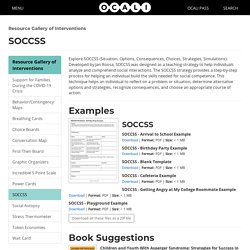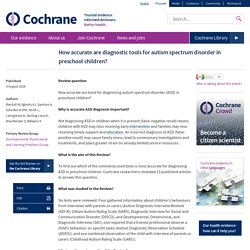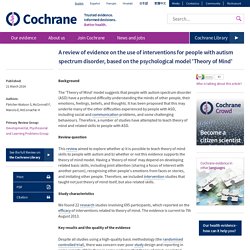

De plus, l'incohérence des résultats et des mesures signifie que les preuves ont été notées comme étant de qualité «très faible» ou «faible» et nous ne pouvons pas être sûrs que les suggestions d'effets positifs seront maintenues à mesure que des preuves de qualité s'accumulent.
D'autres conceptions longitudinales et des échantillons plus importants sont nécessaires pour aider à élucider à la fois l'efficacité des interventions liées à ToM et la valeur explicative du modèle ToM lui-même. Il est possible que l’affinement continu du modèle de gestion des risques conduise à de meilleures interventions qui ont un impact plus important sur le développement que celles étudiées à ce jour.
Autisme : l’enfant et sa difficulté à regarder. Resource Gallery of Interventions. Explore SOCCSS (Situation, Options, Consequences, Choices, Strategies, Simulations).

Developed by Jan Roosa, SOCCSS was designed as a teaching strategy to help individuals analyze and comprehend social interactions. The SOCCSS strategy provides a step-by-step process for helping an individual build the skills needed for social competence. This technique helps an individual to reflect on a problem or situation, determine alternative options and strategies, recognize consequences, and choose an appropriate course of action. SOCCSS - Arrival to School ExampleDownload | Format: PDF | Size: < 1 MB SOCCSS - Birthday Party ExampleDownload | Format: PDF | Size: < 1 MB. L'autisme a la parole. How accurate are diagnostic tools for autism spectrum disorder in preschool children? Review question How accurate are tools for diagnosing autism spectrum disorder (ASD) in preschool children?

Why is accurate ASD diagnosis important? Not diagnosing ASD in children when it is present (false-negative result) means children with ASD may miss receiving early intervention and families may miss receiving timely support and education. An incorrect diagnosis of ASD (false-positive result) may cause family stress, lead to unnecessary investigations and treatments, and place greater strain on already limited service resources. What is the aim of this Review? A review of evidence on the use of interventions for people with autism spectrum disorder, based on the psychological model 'Theory of Mind' Twenty-two randomised trials were included in the review (N = 695).

Studies were highly variable in their country of origin, sample size, participant age, intervention delivery type, and outcome measures. Risk of bias was variable across categories. There were very few studies for which there was adequate blinding of participants and personnel, and some were also judged at high risk of bias in blinding of outcome assessors. A review of evidence on the use of interventions for people with autism spectrum disorder, based on the psychological model 'Theory of Mind'